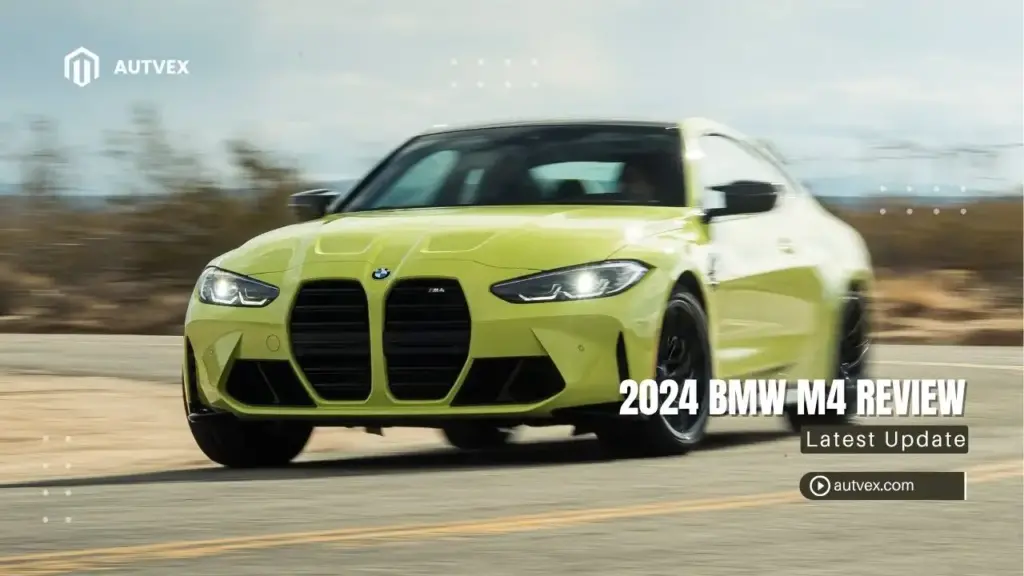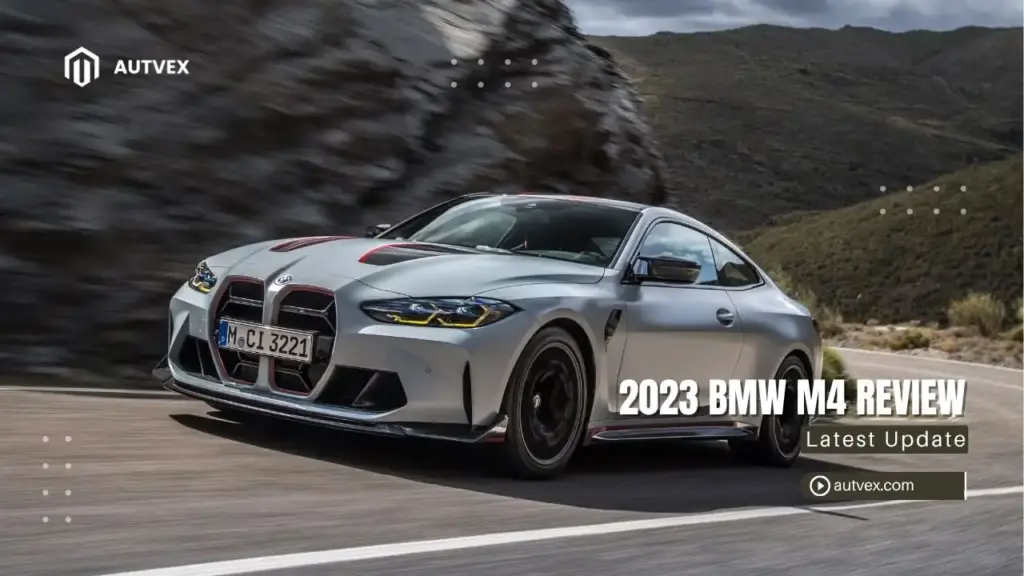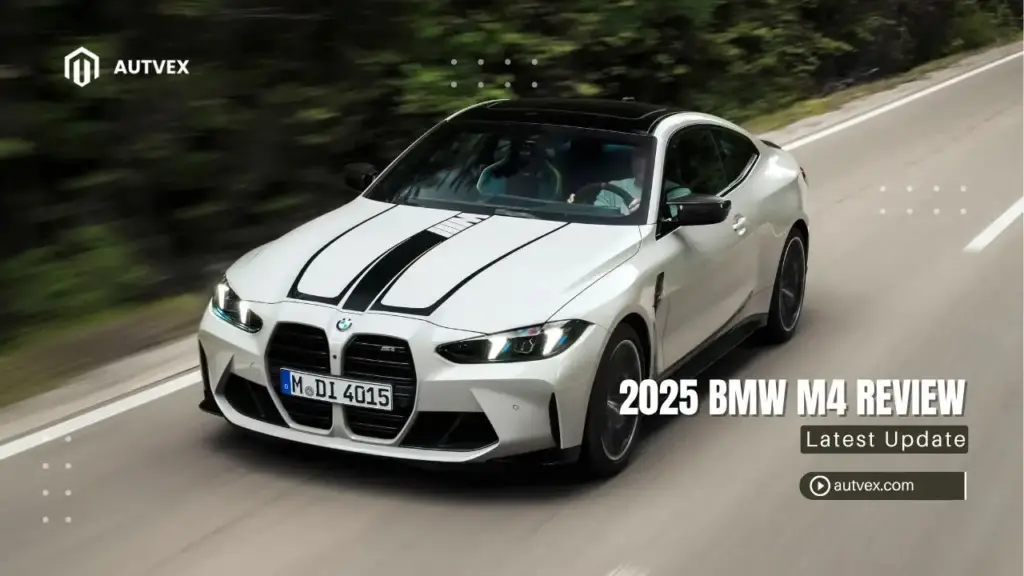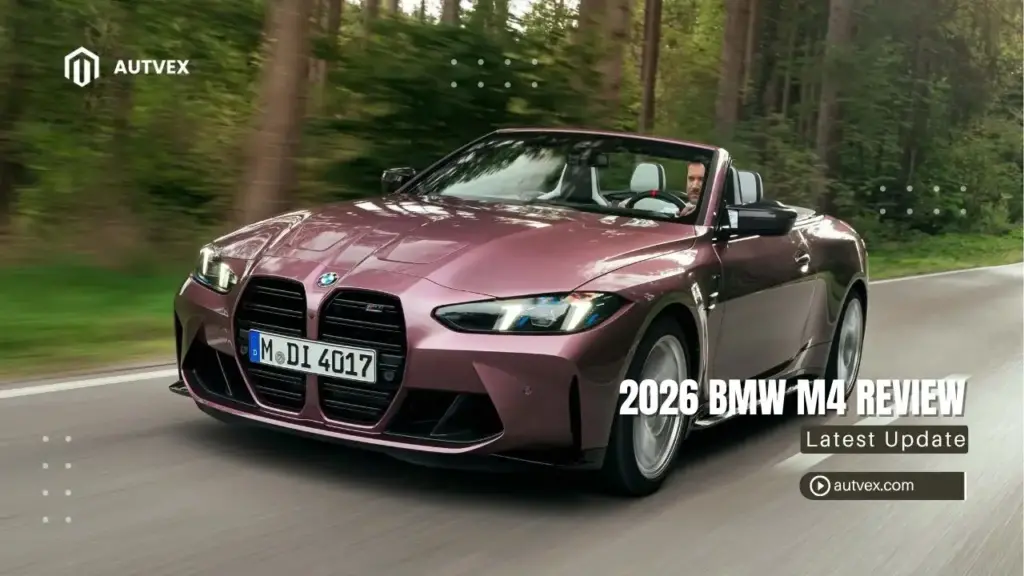You may also like:
The 2024 BMW M4 is a high-performance luxury coupe starting at $78,100 (plus $995 destination), delivering 473 to 503 horsepower from its twin-turbocharged 3.0-liter inline-six engine. The headline update for 2024 brings major technology upgrades including BMW’s new Curved Display with iDrive 8 operating system, combining a 12.3-inch digital instrument cluster and 14.9-inch touchscreen into a single curved unit[1][2]. Available with a six-speed manual transmission on base models, an eight-speed automatic on Competition trims, and optional all-wheel drive on xDrive variants capable of 0-60 mph in a blazing 2.8 seconds, the M4 balances thrilling acceleration with daily usability, though reviewers note its polarizing styling and firm ride quality[1].
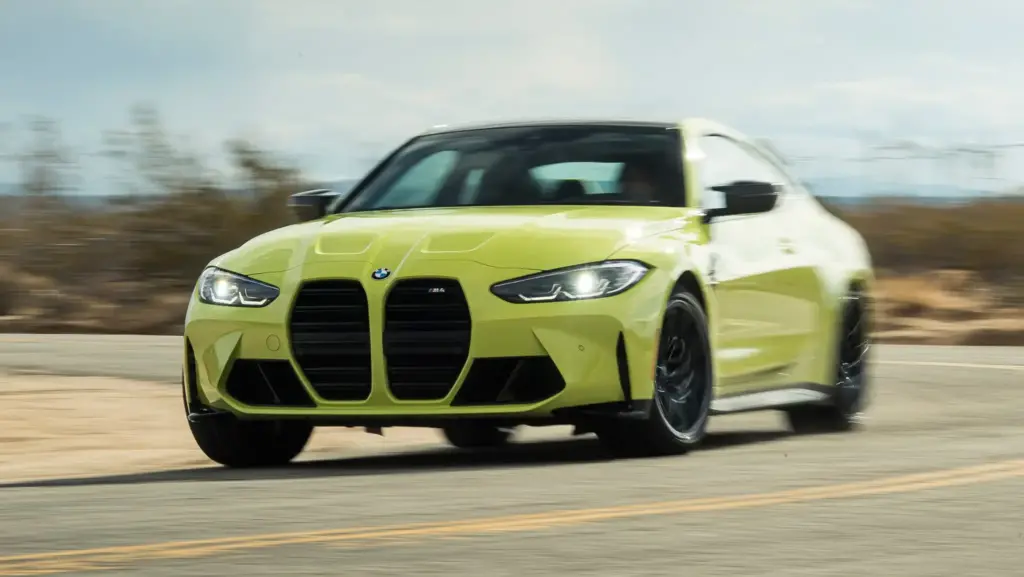
2024 BMW M4 Overview
What’s New for 2024
The 2024 model year brings significant interior technology upgrades to the M4, keeping BMW’s performance coupe competitive in the rapidly evolving luxury segment[2].
Major 2024 updates include:
- BMW Curved Display: New single-unit curved glass housing 12.3-inch digital instrument cluster and 14.9-inch touchscreen[2]
- iDrive 8 operating system: Latest software featuring updated graphics, new menu structures, and refined functionality
- Enhanced voice control: Upgraded BMW Intelligent Personal Assistant voice-command function
- Reduced physical buttons: Cleaner dashboard with climate controls integrated into touchscreen
- New toggle gear selector: Updated center console design (4 Series models)
- Updated interior trim: Aluminum Rhombicle Anthracite replaces previous Tetragon trim[2]
Mechanically, the 2024 M4 carries over from 2023 with minimal changes. It continues as part of the second-generation 4 Series (G82 chassis) introduced in 2021, representing a mature platform refined through multiple model years.
Who Should Consider the 2024 M4
The M4 targets specific buyer profiles seeking performance without complete compromise of daily usability.
Ideal buyers include:
- Manual transmission enthusiasts: The base M4 offers one of the last available six-speed manuals in the luxury performance segment
- Power-hungry performance buyers: Competition xDrive delivers 503 hp with all-wheel-drive traction
- Track-day regulars: Weekend warriors needing a car capable of track duty and Monday commutes
- BMW M loyalists: Enthusiasts appreciating M Division engineering and proven S58 powerplant
The M4 particularly suits buyers who have access to smooth roads or prioritize performance over ride comfort. According to Autvex automotive experts, the M4’s tech-focused updates keep it competitive against rivals like the Mercedes-AMG C 63 and Audi RS5, though buyers seeking pure driving engagement may find better alternatives.
Key Strengths and Weaknesses
Advantages:
| Strength | Details |
|---|---|
| Thrilling acceleration | 0-60 mph as quick as 2.8 seconds (Competition xDrive)[1] |
| Tenacious grip | xDrive models offer incredible cornering stability |
| Manual availability | Six-speed manual preserves driving engagement on base model |
| Luxury interior | Premium materials with latest BMW technology[2] |
Disadvantages:
- Controversial styling: Large vertical kidney grille polarizes opinion
- Firm ride comfort: Sport-tuned suspension creates harsh ride on rough pavement[1]
- Lacking steering feel: Precise but numb compared to rivals[3]
- Complex drive modes: Excessive adjustable settings can feel cumbersome[1]
The 2024 M4 balances performance with daily usability better than pure track weapons, though some enthusiasts criticize it as “too refined” compared to raw predecessors. For buyers navigating the car buying process in the USA, understanding these trade-offs proves essential before committing to this $80,000+ performance coupe.
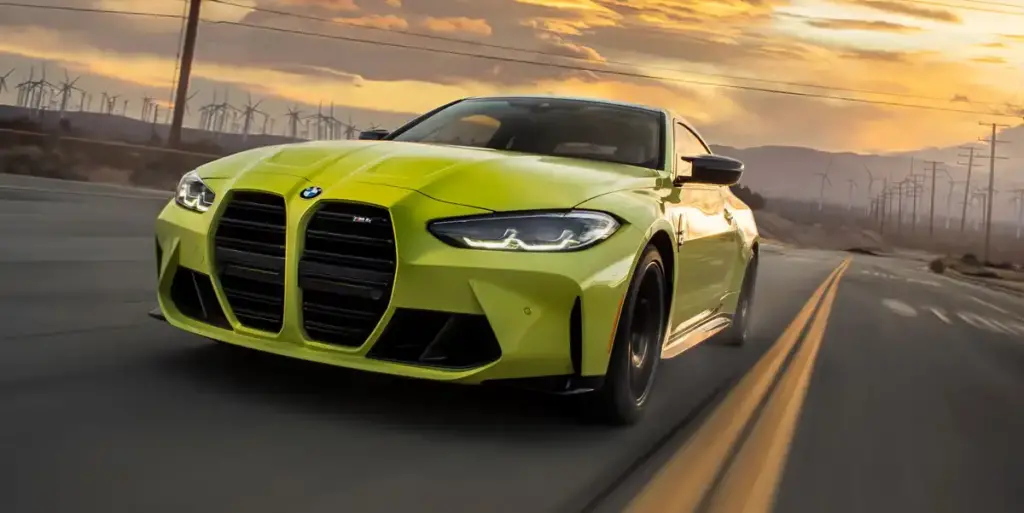
Trim Levels and Pricing
Base M4 Coupe (Manual)
| Specification | Details |
|---|---|
| Starting MSRP | $78,100 (plus $995 destination)[1] |
| Engine | 473 hp @ 6,250 rpm, 406 lb-ft torque |
| Transmission | 6-speed manual (only) |
| Drivetrain | Rear-wheel drive |
| 0-60 mph | 3.8-4.1 seconds[1] |
The base M4 represents the purist’s choice, pairing the S58 inline-six with a traditional three-pedal configuration. Standard equipment includes adaptive M suspension, 18-inch front/19-inch rear staggered wheels, carbon-fiber roof, M Sport seats with Merino leather, and the new BMW Curved Display with iDrive 8[2].
Car and Driver testing measured 0-60 mph in 3.8 seconds and a quarter-mile run of 12.0 seconds at 121 mph—impressive numbers for a manual-transmission sports coupe[1].
M4 Competition Coupe (RWD)
Starting at $82,200, the Competition trim delivers 30 additional horsepower (503 hp total) exclusively through an eight-speed automatic transmission[1].
Competition upgrades include:
- 503 horsepower and 479 lb-ft torque at 2,750 rpm
- Eight-speed M Steptronic automatic with launch control
- 19-inch front/20-inch rear forged bi-color wheels
- Extended Shadowline exterior trim (high-gloss black accents)
- Competition-specific suspension calibration
BMW claims 0-60 mph in 3.8 seconds, matching the manual’s tested time despite additional power. The automatic’s quick shifts and launch control deliver consistent performance, though purists miss the manual’s engagement.
M4 Competition xDrive (Coupe and Convertible)
The xDrive models add BMW’s rear-biased all-wheel-drive system for maximum traction and acceleration[4].
| Body Style | Starting MSRP | 0-60 mph |
|---|---|---|
| Competition xDrive Coupe | $86,300 | 2.8 seconds (Car and Driver)[1] / 3.4 seconds (BMW) |
| Competition xDrive Convertible | $93,300 | 3.6 seconds |
Car and Driver’s real-world testing achieved a blazing 2.8-second 0-60 mph time—a full second quicker than the rear-drive model[1]. This performance rivals supercars costing twice as much, though BMW’s conservative 3.4-second claim suggests variation based on conditions[4].
The xDrive system offers three modes: 4WD (balanced traction), 4WD Sport (rear-biased for spirited driving), and 2WD (pure rear-drive for track fun). This flexibility allows drivers to tailor dynamics to conditions and preferences.
Standard and Optional Equipment
Base features across all trims:
- Adaptive M suspension with electronically controlled dampers
- M Sport Differential (electronic limited-slip)
- Carbon-fiber roof panel (coupe models)
- M Sport seats with enhanced bolstering and illuminated M badges
- BMW Curved Display with 12.3-inch cluster and 14.9-inch touchscreen
- iDrive 8 operating system with wireless Apple CarPlay/Android Auto
- 16-speaker Harman Kardon surround sound
- Front and rear parking sensors
- Active safety features (lane departure warning, blind-spot monitoring)
Optional packages:
- Executive Package: Head-up display, gesture controls, heated steering wheel
- Carbon Package: Additional carbon-fiber exterior components
- M carbon-ceramic brakes ($8,500): Fade-resistant for track use
- Carbon-fiber bucket seats ($4,000): Weight savings with track-focused bolstering
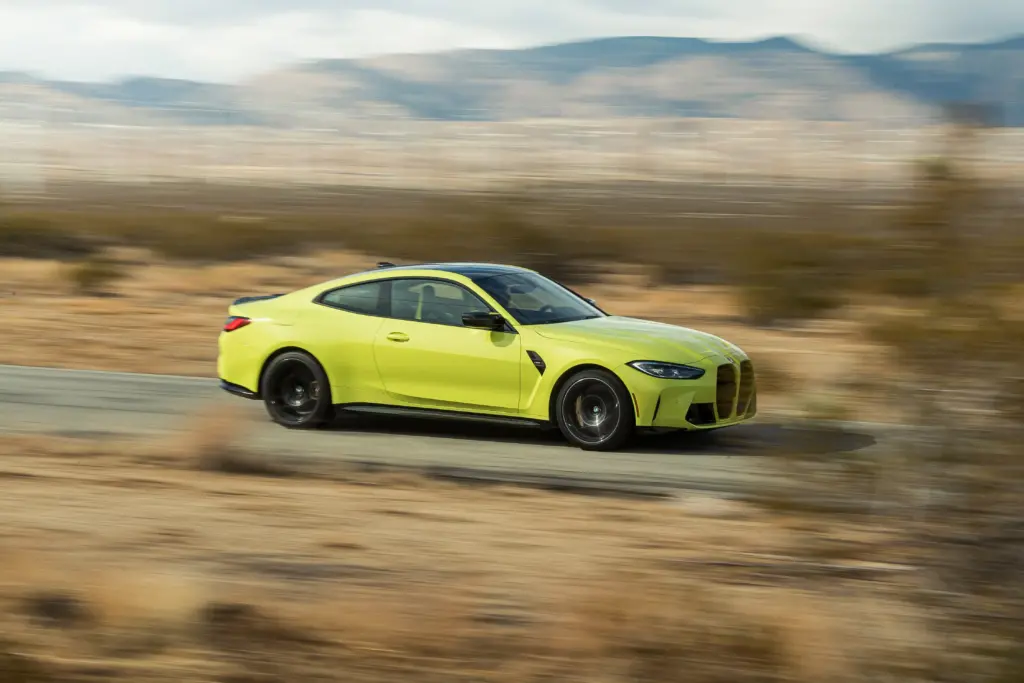
Engine and Performance
S58 Twin-Turbocharged Inline-Six Engine
BMW’s S58 3.0-liter inline-six represents the pinnacle of M Division turbocharged engineering[1].
Engine specifications:
| Trim Level | Horsepower | Torque | Redline |
|---|---|---|---|
| Base M4 | 473 hp @ 6,250 rpm | 406 lb-ft @ 2,650-6,130 rpm | 7,200 rpm |
| Competition | 503 hp @ 6,250 rpm | 479 lb-ft @ 2,750 rpm | 7,200 rpm |
The S58 features twin-scroll turbochargers, high-precision direct fuel injection, and sophisticated thermal management. The engine delivers smooth, forceful power across its rev range, though some enthusiasts note it lacks the characterful sound of naturally-aspirated predecessors.
Interestingly, Motor Trend notes that real-world dyno testing reveals power closer to 550 hp at the crank—significantly more than BMW’s official 503 hp claim[5]. This conservative rating suggests BMW leaves performance headroom for future variants.
Acceleration and Speed Performance
The M4 delivers staggering acceleration regardless of configuration[1].
Tested performance figures:
- Base manual: 0-60 mph in 3.8 seconds, quarter-mile in 12.0 @ 121 mph[1]
- Competition RWD: 0-60 mph in 3.8 seconds (BMW claim)
- Competition xDrive: 0-60 mph in 2.8 seconds (Car and Driver testing)[1]
- Top speed: 155 mph electronically limited (180 mph with optional M Driver’s Package)
The Competition xDrive’s 2.8-second sprint matches exotic supercars while maintaining daily usability—a remarkable achievement for a $86,300 coupe. The xDrive system’s launch control manages wheel spin perfectly, allowing repeatable sub-3-second runs in optimal conditions.
Transmission Options
BMW offers two distinct transmission philosophies catering to different priorities.
Six-speed manual transmission:
- Standard on base M4 Coupe only
- Traditional three-pedal engagement for driving purists
- Lighter weight (approximately 50 pounds vs automatic)
- Tested 0-60 mph: 3.8 seconds[1]
- Last-generation manual in luxury performance segment
Eight-speed M Steptronic automatic:
- Standard on Competition models
- Lightning-quick shifts with steering-mounted paddle shifters
- Launch control for optimal acceleration
- Adaptive shift patterns learning driver behavior
- No manual option on Competition trims
The manual delivers engagement at 7/10ths driving, while the automatic provides superior acceleration and convenience for daily traffic. Enthusiasts debate the trade-off endlessly, though market trends favor the automatic’s popularity.
Drivetrain: RWD vs xDrive AWD
Buyers face a fundamental choice between traditional rear-wheel drive and modern all-wheel drive.
Rear-wheel drive characteristics:
- Traditional M car dynamics with playful oversteer
- Electronic limited-slip differential manages traction
- Lighter weight by approximately 100 pounds
- Lower purchase price ($4,100 less than xDrive)
- Purist preference for rear-drive character
xDrive all-wheel drive advantages:
- Improved traction in all conditions, especially wet/snowy weather
- Faster acceleration: 2.8-second 0-60 mph vs 3.8 seconds RWD[1]
- Adjustable modes: 4WD, 4WD Sport, 2WD
- Year-round usability in northern climates
- 2WD mode allows pure rear-drive fun when desired[1]
The xDrive system operates intelligently with rear bias, sending power forward only when rear traction is exceeded. The ability to switch into 2WD mode provides rear-drive purists their preferred dynamics when conditions allow.
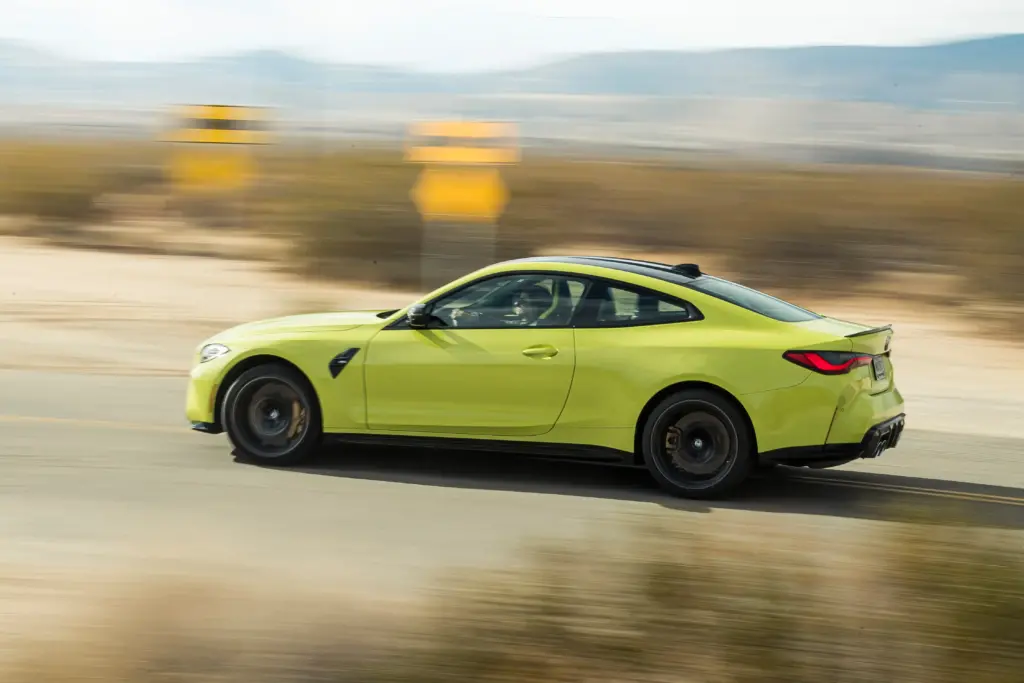
Handling and Driving Dynamics
Chassis and Suspension Setup
The M4’s chassis delivers exceptional capability prioritizing grip over comfort[1].
Key chassis features:
- Adaptive M suspension: Electronically controlled dampers with Comfort, Sport, and Sport Plus modes
- M Sport Differential: Electronic limited-slip managing rear-wheel traction
- Carbon-fiber roof: Standard on coupes, lowering center of gravity
- Weight distribution: Near-ideal balance for handling precision
- Track-tuned setup: Prioritizes maximum cornering grip
Car and Driver testing measured 1.03g on the skidpad—exceptional lateral grip demonstrating the chassis’ capability[1]. However, this track focus creates trade-offs for daily driving comfort.
Steering Feel and Driver Feedback
The M4’s steering represents its most consistent criticism among reviewers[3].
Steering characteristics:
- Precision: Excellent on-center accuracy and quick ratio
- Road feel: Noticeably lacking compared to competitors[3]
- Improvement: Better than previous M4 but still disconnected
- Engagement: Less satisfying than Mercedes-AMG C 63 S or Porsche Cayman GTS
Edmunds specifically notes the steering “lacks road feel,” a significant criticism for a performance coupe where tactile feedback matters[3]. While the M4 places the car exactly where intended, the electronic power steering filters out subtle surface textures enthusiasts crave.
Braking Performance
Standard M Compound brakes provide impressive stopping power[1].
Brake specifications:
- 60-0 mph: 106 feet—shorter than segment average[1]
- 100-0 mph: 291 feet (Car and Driver testing)
- 70-0 mph: 146 feet
- Standard brakes: Adequate for street driving and occasional track use
Optional M carbon-ceramic brakes ($8,500):
- Fade-free performance during repeated track sessions
- Reduced unsprung weight improving handling response
- Expensive maintenance and cold-weather performance compromises
- Recommended primarily for dedicated track enthusiasts
Drive Modes and Customization
The M4 offers extensive configurability that reviewers sometimes describe as excessive[1].
Configurable parameters:
- Engine response: Efficient, Sport, Sport Plus throttle mapping
- Transmission: Shift speed and aggression (automatic only)
- Suspension: Comfort, Sport, Sport Plus damper stiffness
- Steering weight: Light, Medium, Heavy effort levels
- Exhaust sound: Sport mode increases volume; M Sound button provides additional control
- Stability control: Multiple intervention levels including full-off
Two M buttons on the steering wheel store custom configurations for instant recall. However, the sheer number of combinations creates what BMW themselves might admit is needlessly complex[1]. Many owners simply cycle through presets rather than customizing individual parameters.
Ride Quality and Daily Drivability
The M4’s sport-tuned suspension creates a firm ride prioritizing handling over comfort[1].
Ride characteristics:
- Comfort mode: Firm but tolerable for highway cruising
- Sport Plus: Too stiff for street use according to reviewers
- Rough pavement: Uncomfortable and jarring over potholes[1]
- Track capability: Exceptional grip and composure at high speeds
- “Too refined” criticism: Some enthusiasts wanting rawness find it overly controlled
The M4 suits buyers with smooth commutes or those willing to accept firm ride quality for weekend performance. Buyers prioritizing comfort should test-drive extensively on typical local roads before committing. For those seeking better ride quality, the 2025 BMW 540i M Sport offers 70% of performance with significantly improved compliance.
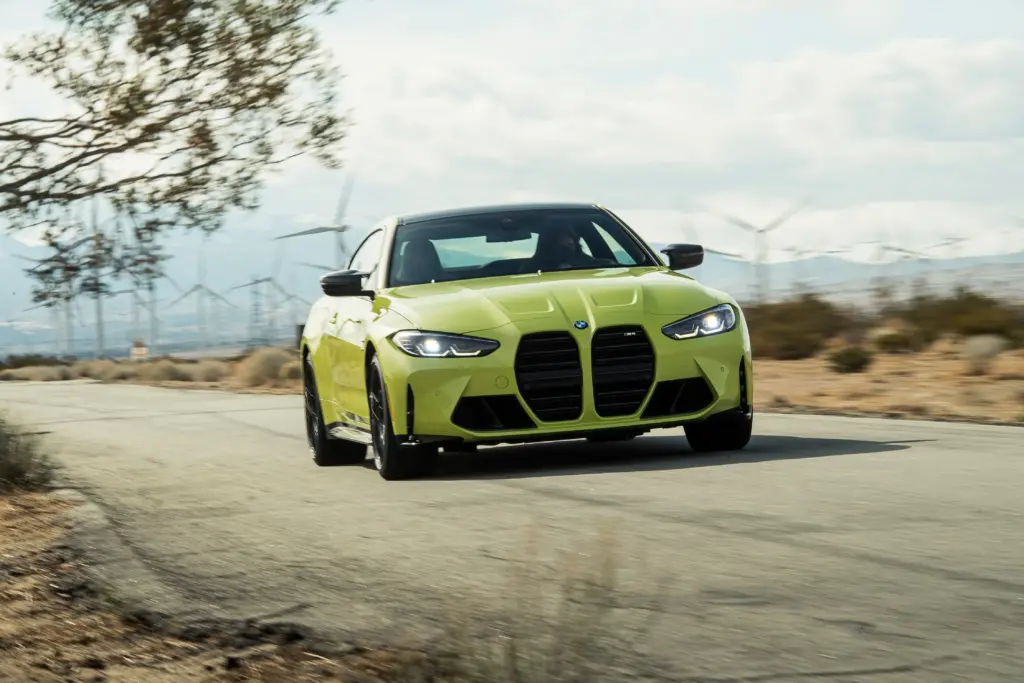
Exterior Design and Style
Controversial Styling and Polarizing Grille
The M4’s most divisive element remains its oversized vertical kidney grille design.
Grille characteristics:
- Size: Dramatically larger than traditional BMW horizontal kidneys
- Orientation: Vertical design inspired by classic BMW models
- M-specific treatment: High-gloss black horizontal slats
- Love-it-or-hate-it: Polarizing aesthetic with few neutral opinions
- Function: Manages airflow for twin-turbo intercoolers and engine cooling
The grille draws consistent criticism in reviews, with some describing it as having “functional aerodynamic purpose” while others simply can’t accept the aesthetic[1]. Potential buyers should view the M4 in person, as photos often exaggerate or minimize the visual impact depending on angle and lighting.
Bold and Athletic Coupe Styling
Beyond the grille, the M4 features muscular, purposeful design[2].
Design elements:
- Dense, muscular bodywork emphasizing width and stance
- Flared fenders accommodating wide performance tires
- Sculpted hood with flowing character lines
- Aerodynamic front splitter and functional air intakes
- Aggressive roofline flowing into integrated rear spoiler
The M4’s proportions convey performance intent even when stationary. Wide hips, short overhangs, and prominent wheel arches create athletic presence distinguishing it from standard 4 Series models.
M-Specific Design Elements
M Division adds distinctive performance cues throughout[2].
M4-exclusive features:
- Quad 100mm exhaust pipes: Prominent rear diffuser integration with blaring intensity
- Carbon-fiber roof: Standard on coupes, reducing weight and lowering center of gravity
- Extended Shadowline trim: High-gloss black mirror caps, window surrounds, exhaust tips (Competition)
- M4 Competition badges: Unique badging and logos
- Optional M design graphics: Available in High Gloss Black or Red for hood and trunk[2]
These elements create cohesive M-specific identity separating performance variants from standard luxury coupes.
Convertible Body Style (Competition xDrive Only)
The M4 Convertible exclusively comes in Competition xDrive specification with a power-retractable soft top.
Convertible specifications:
| Feature | Details |
|---|---|
| Top operation | Opens in 18 seconds, functional up to 31 mph |
| Soft top options | Standard black or optional Moonlight Black with metallic sheen |
| Weight penalty | Approximately 300 pounds heavier than coupe |
| Performance impact | 0-60 mph in 3.6 vs 3.2 seconds (coupe) |
| Starting price | $93,300 vs $86,300 (coupe) |
The multi-layer soft top provides excellent noise insulation when raised, though open-air driving introduces wind buffeting typical of convertibles. The $7,000 premium and performance compromises make the convertible a niche choice for buyers prioritizing top-down motoring.
Wheel and Tire Options
Standard configurations:
- Base M4: 18-inch front / 19-inch rear staggered wheels
- Competition: 19-inch front / 20-inch rear bi-color forged wheels
- High-performance tires: Michelin Pilot Sport 4S or similar compounds
Optional forged lightweight wheels reduce unsprung weight improving handling response and ride quality marginally. However, larger wheel diameters exacerbate the already-firm ride on rough pavement.
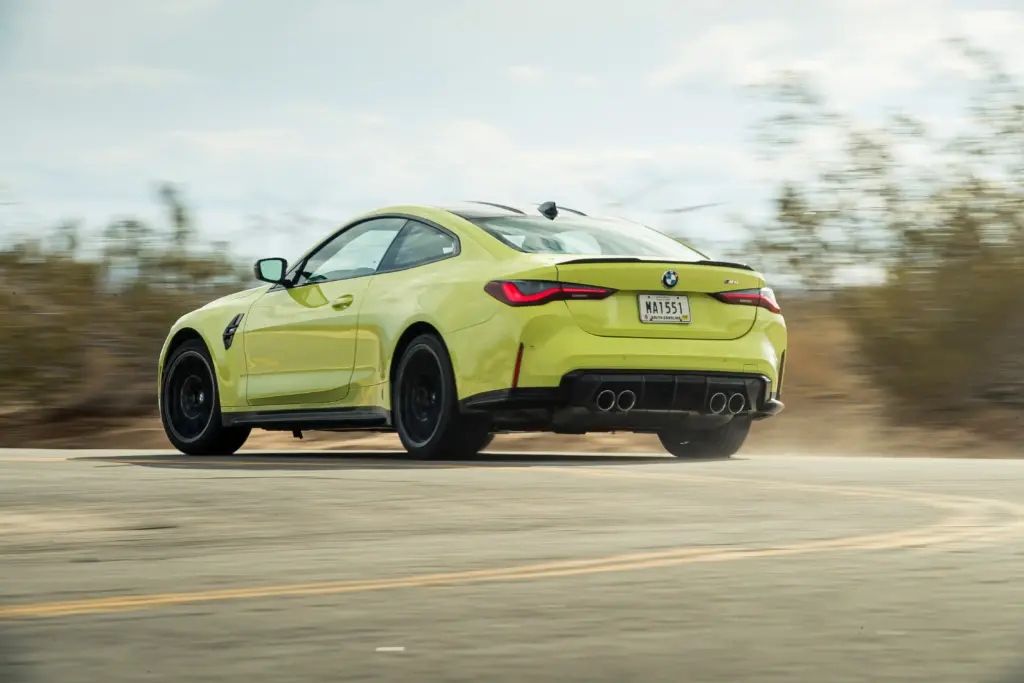
Available Exterior Colors
Standard Paint Options
The 2024 M4 offers diverse color choices catering to different aesthetic preferences.
Available colors:
| Color Name | Type | Additional Cost |
|---|---|---|
| Alpine White | Solid | No charge |
| Sao Paulo Yellow | Solid | No charge |
| Black Sapphire Metallic | Metallic | $550 |
| Brooklyn Grey Metallic | Metallic | $550 |
| Skyscraper Grey Metallic | Metallic | $550 |
| Isle of Man Green Metallic | Metallic | $550 |
| Portimao Blue Metallic | Metallic | $550 |
| Toronto Red Metallic | Metallic | $550 |
| Tanzanite Blue II Metallic | Metallic | $550 |
Metallic paints add depth and premium appearance compared to solid colors, justifying the $550 upcharge for most buyers.
BMW Individual and Special Colors
BMW Individual extends the palette with exclusive premium options.
Individual colors:
- Individual Dravit Grey Metallic: Sophisticated grey-green hue
- Individual Frozen Brilliant White: Matte white finish requiring specialized care
- Individual Frozen Portimao Blue: Matte version of signature M color
- Custom color matching: Any color possible with extended 12-16 week lead time
Individual colors command premiums from $2,500 to $5,000 depending on complexity. Matte finishes require specialized maintenance and cannot be polished, making them high-maintenance choices for daily drivers.
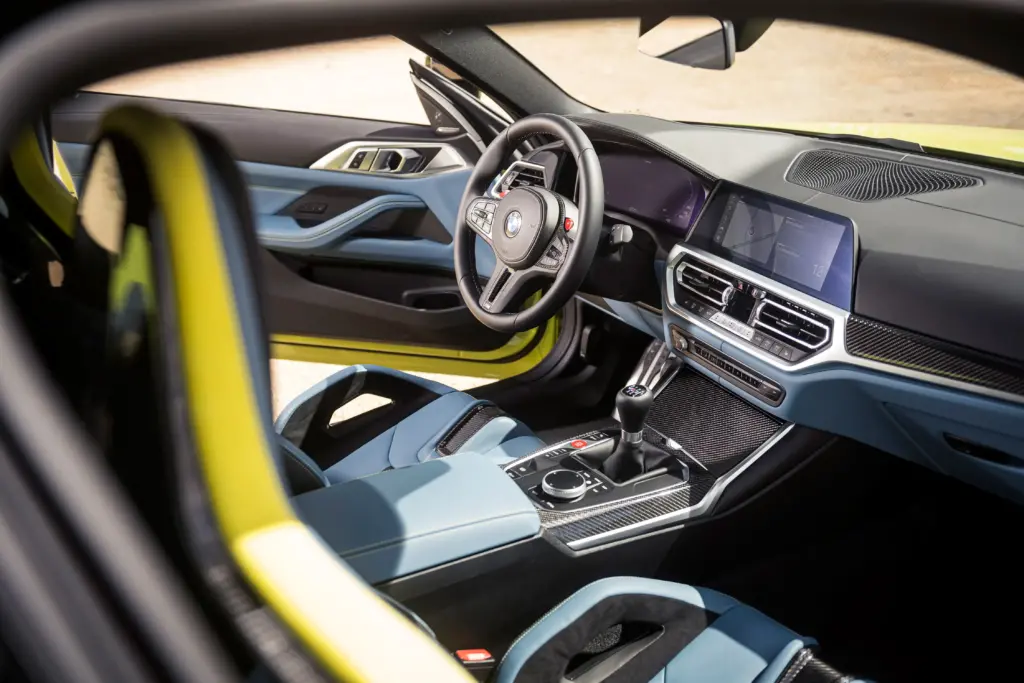
Interior and Cabin Quality
Seating and Premium Materials
The M4 cabin balances performance focus with luxury appointments[2].
Seating options:
| Seat Type | Features | Cost | Notes |
|---|---|---|---|
| M Sport seats | Merino leather, enhanced bolstering, illuminated M badges | Standard | Excellent balance of support and comfort |
| Heated seats | Front seats heated | Standard | Rear heated seats optional |
| Ventilated seats | Cooling airflow | Optional | Recommended for warm climates |
| Carbon-fiber bucket seats | Ultra-bolstering, significant weight savings | $4,000 | Uncomfortable for some; thin padding, bothersome seat bump for shorter drivers |
Reviewers consistently praise standard M Sport seats for providing all-day comfort while delivering track-worthy lateral support. The carbon bucket seats serve dedicated track enthusiasts but compromise daily usability through tight entry/exit and firm padding.
Interior Color Combinations and Trims
BMW offers eight interior color schemes allowing personalization[2].
Available combinations:
- Black: Classic performance aesthetic
- Yas Marina Blue/Black with Yellow Accent: Bold M signature color
- Silverstone/Black: Sophisticated grey tones
- Kyalami Orange/Black: Vibrant racing-inspired
- Fiona Red/Black: Dramatic red leather
- Tartufo: Rich brown creating warmth
- Ivory White: Light-colored luxury requiring maintenance
- Fjord Blue/Black: Contemporary blue-grey
Interior trim options:
- M Fine Brushed Aluminum: Sporty metallic finish
- Aluminum Rhombicle Anthracite: New geometric texture for 2024 (standard)[2]
- Carbon Fiber: Motorsport-inspired weave pattern
The plethora of options allows buyers to create distinctive cabins, though some find the button-heavy layout busy compared to minimalist competitors.
Rear Seat Space and Practicality
Performance coupes sacrifice rear-seat practicality by design.
Rear seat characteristics:
- Legroom: Small but usable for children or short trips
- Access: Long doors make entry/exit somewhat difficult
- Child seats: Reasonably accommodated despite coupe limitations
- Comparison: More space than many competitors in segment
- Reality: Four-passenger capacity with coupe compromises
Buyers needing regular four-adult transport should strongly consider the BMW M3 sedan, which offers identical performance with vastly improved rear access and space.
Cargo and Trunk Space
The M4 provides adequate cargo capacity for a performance coupe.
Trunk specifications:
- Coupe: Approximately 12 cubic feet
- Convertible (top up): 11 cubic feet
- Convertible (top down): Reduced significantly by soft top mechanism
- Comparison: More cargo space than many segment competitors
Split-folding rear seats expand capacity for track-day tire sets or weekend luggage. The trunk opening proves wide enough for golf bags or multiple soft suitcases, making weekend getaways feasible.
Interior Fit and Finish
BMW maintains excellent interior quality standards throughout the M4[2].
Quality highlights:
- Premium materials: Genuine Merino leather, soft-touch surfaces
- Driver-focused layout: Controls angled toward driver
- Physical controls maintained: Not exclusively touchscreen[2]
- Build quality: Precise panel gaps and solid construction
- Technology integration: Curved Display seamlessly incorporated
Some enthusiasts appreciate the plethora of physical buttons and knobs allowing tactile control without touchscreen interaction. However, others find the busy dashboard cluttered compared to minimalist rivals.
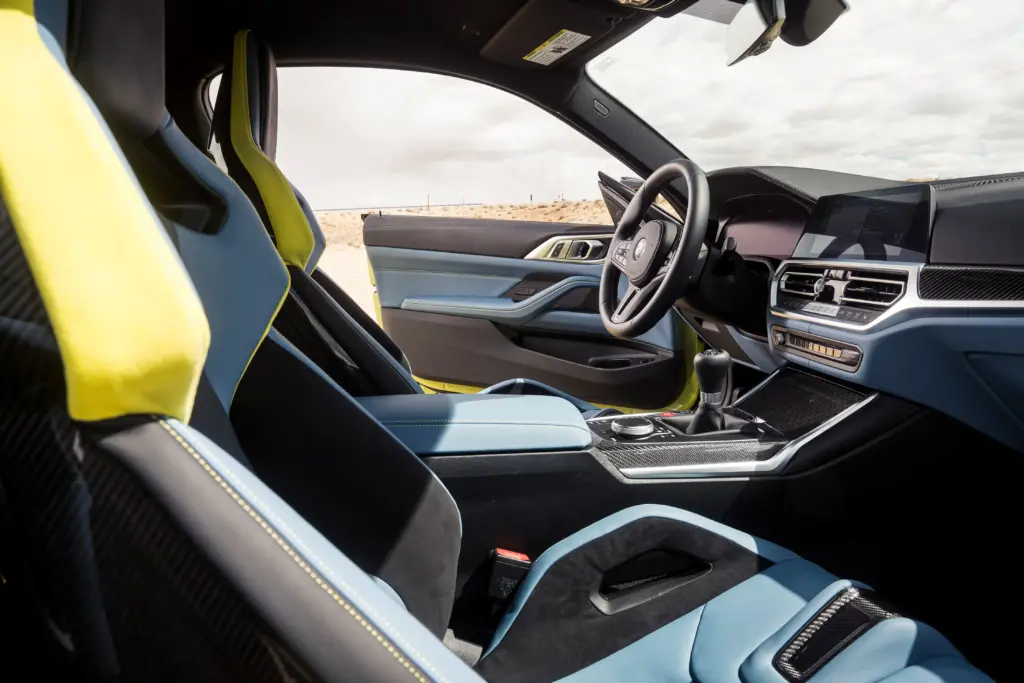
Technology and Infotainment
BMW Curved Display with iDrive 8 (New for 2024)
The headline upgrade for 2024 brings BMW’s latest infotainment system[2].
Display specifications:
- 12.3-inch digital instrument cluster: Fully configurable with multiple layout options
- 14.9-inch central touchscreen: High-resolution display with haptic feedback
- Single curved unit: Seamless integration under unified curved glass[2]
- iDrive 8 software: Latest operating system with updated graphics and menu structures
- M-specific displays: Performance data including g-forces, boost pressure, lap timers
The Curved Display replaces previous separate screens, creating cleaner dashboard aesthetics. Climate controls migrated to the touchscreen, though they remain accessible at the bottom for quick adjustments[2].
Control Methods and User Interface
BMW provides multiple control methods accommodating different preferences[2].
Interface options:
- Direct touchscreen: Responsive touch with haptic confirmation
- iDrive rotary controller: Maintained on center console for tactile control
- Voice commands: Refined BMW Intelligent Personal Assistant[2]
- Steering wheel controls: Dedicated buttons and scroll wheels
- Physical buttons: Key functions retain tactile controls
The learning curve proves steep due to feature-rich complexity. Reviewers note the system “can be complicated on the go,” suggesting owners should familiarize themselves during stationary periods[2].
Smartphone Integration
Wireless connectivity comes standard, eliminating cable clutter[2].
Connectivity features:
- Wireless Apple CarPlay: Seamless iPhone integration (standard)
- Wireless Android Auto: Full-featured Android integration (standard)
- Wireless charging pad: Convenient phone charging (center console)
- Cloud-based connectivity: Over-the-air updates and remote functions
- Wi-Fi hotspot: Subscription-based mobile internet
Most buyers appreciate wireless connectivity, though some note phones can slide in the center console charging pad during spirited driving.
Audio and Entertainment Systems
The 16-speaker Harman Kardon surround sound system comes standard—a feature often optional on lower BMW models[1].
Audio specifications:
- 16 speakers throughout cabin
- Premium sound quality suitable for performance vehicle
- Optional upgrades available (Bowers & Wilkins)
- Standard inclusion represents value advantage
The standard Harman Kardon system satisfies most buyers, delivering clear vocals and tight bass appropriate for the M4’s character.
Navigation and Connected Services
Built-in navigation with real-time traffic comes standard[2].
Navigation and services:
- Real-time traffic: Dynamic routing avoiding congestion
- BMW ConnectedDrive: Remote vehicle functions via smartphone
- Over-the-air updates: Software improvements without dealer visits
- Digital key: Phone-based vehicle access
- Remote climate: Pre-conditioning HVAC before entering
Services require subscription after initial complimentary period, though many buyers rely on smartphone navigation instead.
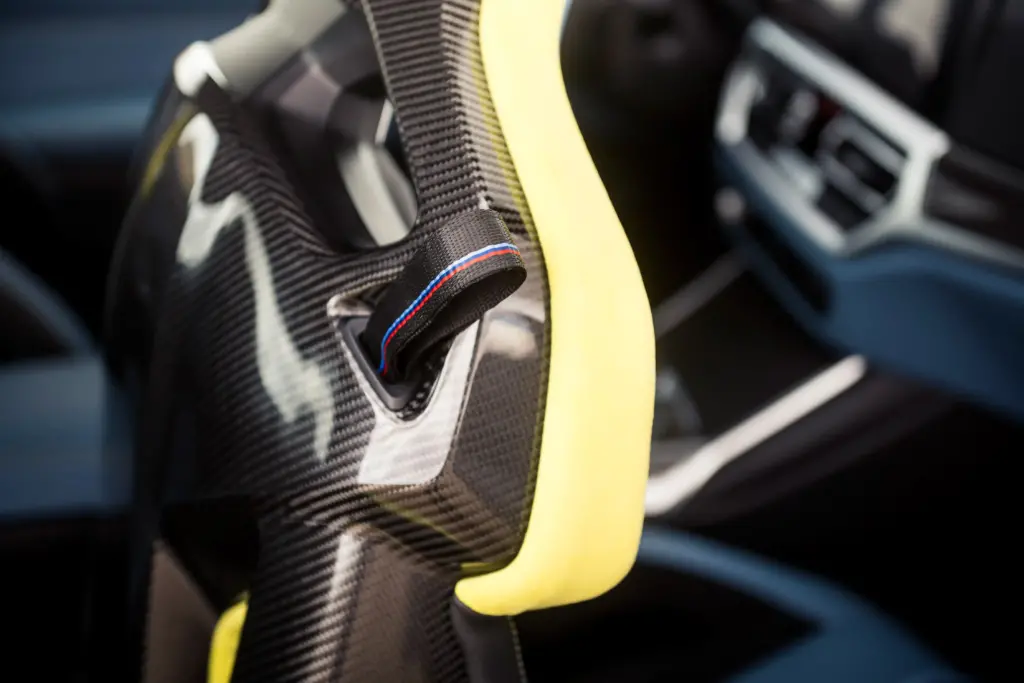
Safety and Driver Assistance
Standard Safety Features
The 2024 M4 includes comprehensive active safety technologies as standard equipment.
Standard safety systems:
- Lane departure warning: Audio and visual alerts when drifting
- Active blind-spot detection: Monitors adjacent lanes for vehicles
- Active lane-keeping assist: Gentle steering corrections maintaining position
- Rearview camera: Backup camera with guidelines (standard)
- Front and rear parking sensors: Distance warnings when maneuvering
- Multiple airbags: Comprehensive airbag system for all occupants
BMW’s driver aids function helpfully without being overly sensitive—a balance some competitors struggle to achieve.
Advanced Driver Assistance Packages
Optional packages add semi-autonomous capabilities for highway driving.
Available features:
- Adaptive cruise control: Maintains set following distance with stop-and-go
- Frontal collision warning: City braking function
- Traffic jam assistance: Steering and speed control in congestion
- Extended traffic jam assistant: Enhanced low-speed automation
- Parking Assistant Plus: Automated parallel and perpendicular parking
While not full autonomous driving, these features reduce fatigue during long highway journeys or congested commutes.
Parking and Visibility Technology
Standard parking sensors assist with tight maneuvering.
Parking technologies:
- Park distance control: Front and rear sensors (standard)
- 3D Surround View: 360-degree overhead camera view (optional)
- Automated parking: System steers into spaces (optional)
- Backup camera: Standard with dynamic guidelines
The M4’s wide body and limited rear visibility make parking assistance worthwhile, particularly for urban environments.
Airbags and Crash Protection
The M4 includes comprehensive passive safety systems.
Safety features:
- Dual front airbags with multi-stage deployment
- Front side-impact airbags integrated into seats
- Side-curtain airbags for front and rear occupants
- Advanced body structure with crumple zones
- Performance engineering balanced with occupant protection
Crash Test Ratings and Reliability
Neither NHTSA nor IIHS has published crash test ratings for the 2024 M4, as low-volume performance vehicles often don’t undergo full testing protocols.
Reliability considerations:
BMW’s brand reliability ranks 30th of 32 manufacturers according to RepairPal. Common M4 issues reported by owners include:
- Crank hub failure: Most serious issue potentially causing engine damage
- Oil leaks: Rocker cover, oil filter housing, and sump gasket failures
- PCV valve problems: Known issue on S55/S58 engines causing rough idle
- Turbocharger wear: Turbos showing signs of wear after 50,000 miles
- Brake costs: Expensive replacements exceeding $1,000 for full set
Autvex automotive analysts recommend thorough pre-purchase inspections on used M4s, particularly checking for known crank hub and oil leak issues. The 4-year/50,000-mile warranty provides peace of mind during initial ownership.
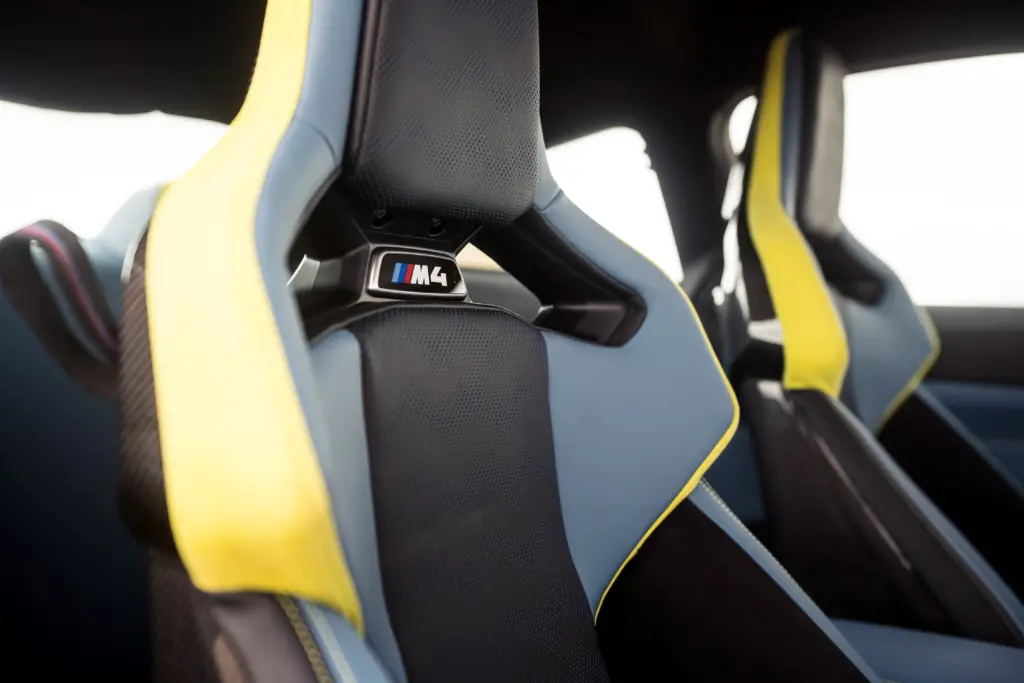
Fuel Economy and Real-World MPG
EPA Fuel Economy Ratings
Official EPA ratings prove reasonable for the performance class[1].
| Configuration | City MPG | Highway MPG | Combined MPG |
|---|---|---|---|
| Base Manual | 16 | 23 | 19 |
| Competition RWD | 16 | 23 | 19 |
| Competition xDrive | 15-16 | 22 | 18 |
| Convertible | 16 | 23 | 18 |
The M4’s efficiency proves competitive with rivals including the Audi RS5 (18-19 combined) and superior to thirstier alternatives like certain AMG models.
Real-World Fuel Economy Testing
Car and Driver observed 17 mpg in mixed driving—matching EPA combined estimates reasonably well[1]. Highway efficiency improves significantly with disciplined driving achieving low-to-mid 20s.
Real-world efficiency:
- Highway cruising: 23-25 mpg possible at steady speeds
- Mixed driving: 17-19 mpg typical for daily commuting
- Aggressive driving: 12-14 mpg during spirited runs
- Track use: Single-digit efficiency under sustained high load
Driving style dramatically impacts consumption. Taking advantage of the M4’s 503 hp drops efficiency into the teens, while disciplined highway cruising approaches EPA estimates.
Fuel Requirements and Operating Costs
Premium unleaded gasoline (91+ octane) is mandatory for optimal performance[1].
Fuel specifications:
- Fuel requirement: Premium unleaded (91+ octane required)
- Tank capacity: 15.6 gallons
- Combined range: Approximately 296 miles (19 mpg × 15.6 gallons)
- Highway range: Approximately 360 miles (23 mpg × 15.6 gallons)
Annual fuel costs:
EPA estimates $3,100-$3,300 annually assuming 12,000 miles and current premium fuel prices. This compares favorably to competitors like the Lexus RC F (similar $3,200 estimate) despite the Toyota’s naturally-aspirated V8.
Using regular gasoline triggers knock sensors reducing power and efficiency while potentially causing long-term engine damage. Always use premium fuel as specified.
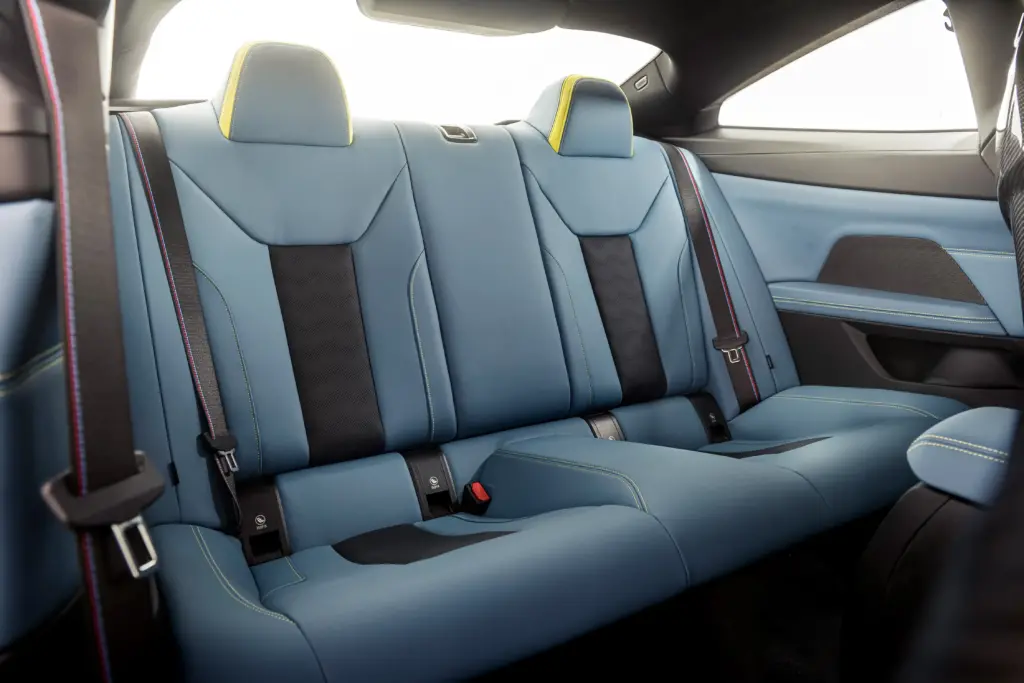
Warranty and Maintenance
Factory Warranty Coverage
BMW provides competitive coverage matching segment standards.
Warranty terms:
| Coverage Type | Duration/Mileage |
|---|---|
| Basic warranty | 4 years / 50,000 miles |
| Powertrain warranty | 4 years / 50,000 miles |
| Corrosion perforation | 12 years / unlimited miles |
This warranty structure matches Audi and Mercedes-AMG, providing average coverage for the luxury performance class.
Complimentary Scheduled Maintenance
BMW includes scheduled maintenance at no cost for 3 years or 36,000 miles—an excellent inclusion providing significant value[1].
Covered services:
- Oil and filter changes at recommended intervals
- Brake fluid replacement
- Multi-point vehicle inspections
- Scheduled services per maintenance schedule
- Software updates addressing bugs or adding features
This represents approximately $2,100-$2,800 value based on typical BMW dealership labor rates. Mercedes-AMG and Audi charge for maintenance from day one, making BMW’s inclusion a competitive advantage.
Roadside Assistance and Extended Warranty
Roadside assistance:
BMW provides 4 years / unlimited miles roadside assistance—excellent coverage exceeding many competitors.
Extended warranty options:
- BMW Ultimate Care+: Extends coverage beyond factory terms
- Certified Pre-Owned warranty: Used M4s receive extended coverage to 6 years/100,000 miles from original in-service date
- Extended service plans: Available covering maintenance beyond complimentary period
Extended warranty value depends on ownership duration and annual mileage. Buyers planning 3-4 year ownership typically skip extended coverage, while long-term owners benefit from protection against expensive repairs.
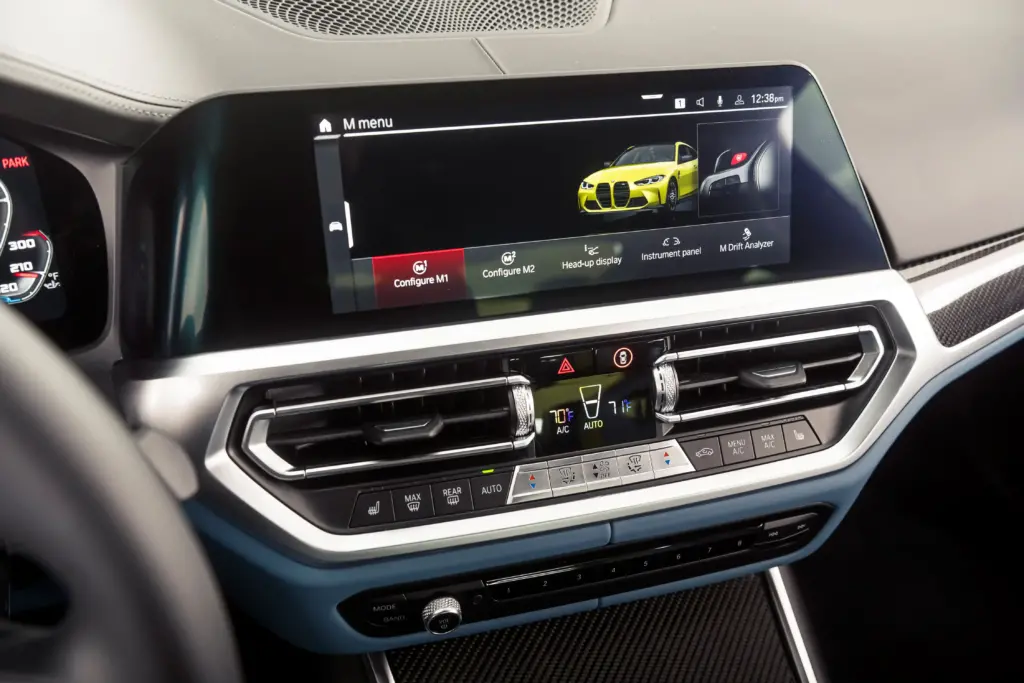
Used 2024 BMW M4 Market
Depreciation and Resale Value
Luxury performance vehicles experience aggressive depreciation, and the M4 follows typical patterns.
Depreciation analysis:
| Time Period | Retained Value | Depreciation | Estimated Loss* |
|---|---|---|---|
| 1 Year (2025) | 73% | 27% | $29,318 |
| 2 Years (2026) | 70% | 30% | $32,457 |
| 3 Years (2027) | 60% | 40% | $44,054 |
| 5 Years (2029) | 46% | 54% | $59,076 |
*Based on $110,135 purchase price (MSRP with typical options)
The M4 loses approximately $29,000 in the first year—typical for luxury performance cars. The 5-year depreciation of 54% exceeds the 44% segment average, making the M4 a better value proposition used than new.
Best Time to Buy Used
Current 2024 M4 models represent relatively fresh inventory offering modest savings versus new.
Used buying strategy:
- Current 2024 models: 1 year old with 8,000-15,000 miles saving $10,000-$15,000
- Optimal timing: 2-3 year old models will offer best value saving $32,000-$44,000
- CPO benefits: Extended warranty and 360-point inspection justify small premium
- Private party: Save 5-8% versus dealer retail but sacrifice warranty
For buyers evaluating acceptable mileage on used performance cars, M4s with documented maintenance history remain viable through 60,000-70,000 miles if properly maintained.
What to Inspect on Used M4s
Pre-purchase inspection priorities:
- Service history: Verify all scheduled maintenance performed
- Known issues: Check for crank hub failure symptoms, oil leaks, PCV valve problems
- Track use indicators: Inspect brake pad/rotor thickness, tire wear patterns
- Paint thickness: Measure to identify unreported collision repairs
- Avoid modified examples: Modified M4s often have reliability concerns
- Compression testing: Check engine health on higher-mileage examples
The crank hub failure represents the most serious potential issue, capable of causing catastrophic engine damage. Buyers should specifically inquire whether preventative measures have been taken.
Used Pricing Trends and Market Availability
Current used 2024 M4 market (October 2025):
Kelley Blue Book estimates:
- Trade-in value: $64,923
- Private party value: Approximately $68,605
- Dealer retail value: $70,000-$75,000 depending on trim and condition
Market observations:
- Competition and xDrive models command $4,000-$8,000 premiums
- Manual transmission examples show slight premium in enthusiast markets
- Geographic variations significant—coastal markets command premiums versus Midwest
- Dealer retail prices typically 8-12% higher than private party
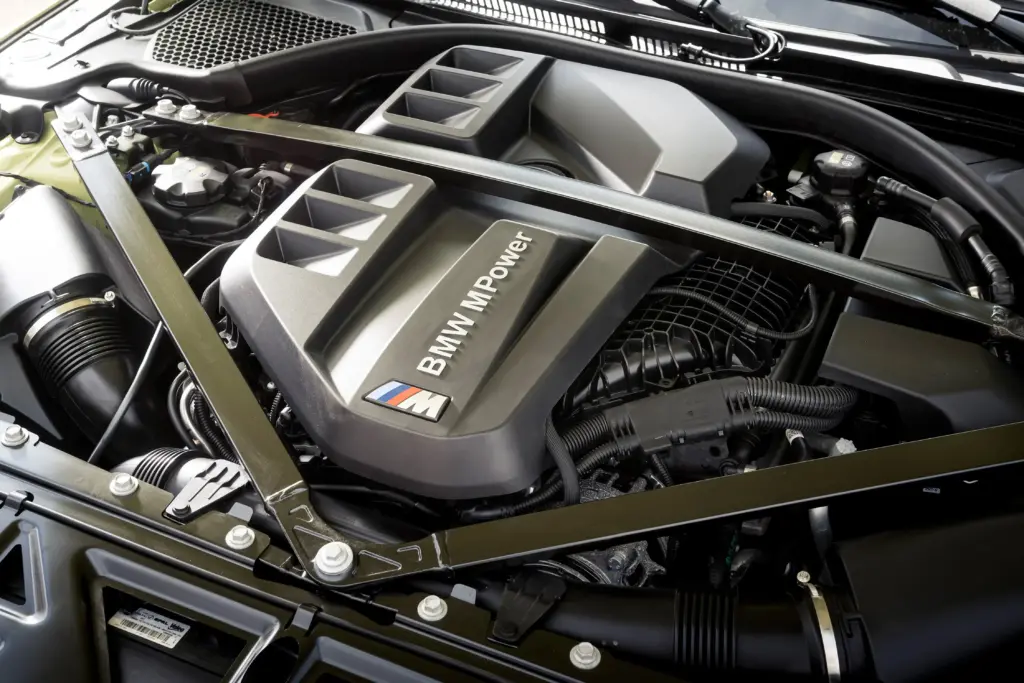
Competitive Comparison and Alternatives
2024 BMW M4 vs Mercedes-AMG C 63 S Coupe
The Mercedes-AMG C 63 S represents the M4’s primary German rival.
Comparison:
| Factor | BMW M4 Competition | Mercedes-AMG C 63 S |
|---|---|---|
| Engine | 3.0L twin-turbo I-6 | 4.0L twin-turbo V-8 |
| Power | 503 hp | 503 hp (2023 model) |
| Driving engagement | Good | More thrilling (noted by reviewers) |
| Technology | iDrive 8 (2024) | MBUX |
| Starting price | $82,200 | ~$85,000 |
Reviewers consistently note the C 63 S provides more thrilling driving engagement despite similar specifications. The V-8’s character and superior steering feel give Mercedes an edge for pure enthusiasts, though the M4 counters with better technology and manual availability.
2024 BMW M4 vs Audi RS5
The Audi RS5 offers understated performance in Sportback hatchback form.
Key differences:
M4 advantages:
- 59 additional horsepower (503 hp vs 444 hp)
- Manual transmission available (base model)
- Rear-wheel-drive option for dynamics
- More aggressive styling
RS5 advantages:
- Sportback practicality with rear hatchback
- More understated exterior design
- Similar fuel economy (18-19 combined)
- Standard Quattro AWD with excellent traction
The RS5 suits buyers prioritizing daily usability and subtle performance, while the M4 serves those wanting maximum power and dramatic styling.
2024 BMW M4 vs Porsche Cayman GTS 4.0
The Porsche Cayman GTS 4.0 represents the segment’s driving engagement benchmark.
Comparison:
- Driving engagement: Cayman noted as more thrilling by multiple reviewers
- Engine character: Naturally-aspirated flat-six vs twin-turbo inline-six
- Price premium: Cayman starts approximately $15,000 higher
- Practicality: M4 offers rear seats and more cargo space
- Brand prestige: Porsche cachet versus BMW M heritage
The Cayman delivers superior driving engagement through mid-engine balance and naturally-aspirated throttle response. However, the M4 provides more power, practicality, and value for buyers not requiring absolute driving purity.
2024 BMW M4 vs Ford Mustang Mach 1
The Ford Mustang Mach 1 represents American muscle at lower pricing.
Value proposition:
- Starting price: Mustang approximately $25,000 less than M4
- Engine character: Naturally-aspirated V-8 versus turbo inline-six
- Track capability: Both offer impressive performance for the money
- Technology: M4 significantly more advanced
- Brand perception: American muscle versus German precision
The Mach 1 appeals to budget-conscious enthusiasts accepting Ford’s less-refined execution for dramatic cost savings.
2024 BMW M4 vs Lexus RC F
The Lexus RC F prioritizes reliability and naturally-aspirated character.
Comparison:
- Reliability: Lexus reputation significantly stronger than BMW
- Engine: Naturally-aspirated 5.0L V-8 versus turbo 3.0L inline-six
- Fuel economy: Similar despite engine differences (18 combined)
- Technology: M4’s iDrive 8 more advanced than Lexus interface
- Maintenance: Lexus significantly lower long-term costs
The RC F suits buyers prioritizing reliability and V-8 character over cutting-edge performance and technology.
BMW M3 vs M4: Which to Choose
The M3 sedan and M4 coupe share identical powertrains differing only in body style.
Decision factors:
| Consideration | M3 Advantage | M4 Advantage |
|---|---|---|
| Practicality | Four doors, adult rear seating | Coupe styling |
| Rear access | Easy rear door entry | Requires folding front seats |
| Weight | Slightly heavier | 55 pounds lighter |
| Styling | Subtle performance sedan | Aggressive coupe presence |
| Resale | Broader appeal | Niche market |
Performance proves virtually identical. Buyers needing regular rear-seat transport should choose the M3 without question. The M4 serves enthusiasts prioritizing style over practicality.
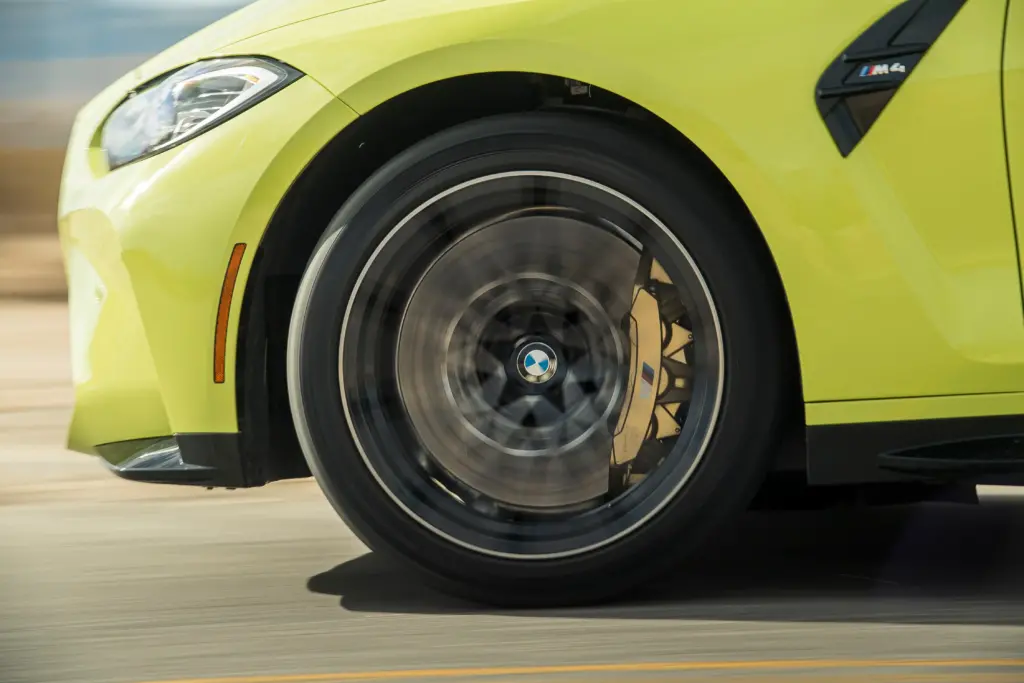
Is the 2024 BMW M4 Worth It?
Best Use Cases for the M4
The M4 excels in specific scenarios where its strengths align with buyer priorities.
Ideal ownership profiles:
- Manual transmission enthusiasts: Last-generation six-speed availability
- Track-day regulars: Weekend warrior needing daily driver capability
- Performance buyers accepting “too refined” character: Those prioritizing speed over raw engagement
- All-weather performance seekers: xDrive models provide year-round capability
The M4 particularly suits buyers owning additional vehicles for family duties, allowing the coupe to serve purely as weekend driver and occasional track car.
Who Should Skip the M4
Certain buyer profiles will find the M4’s compromises unacceptable.
Buyers who should look elsewhere:
- Raw driving experience seekers: Numb steering disappoints engagement purists
- Comfort-first buyers: Harsh ride quality unsuitable for daily comfort priorities
- Grille styling opponents: Controversial design won’t grow on skeptics
- Steering feel prioritizers: Less engaging than competitors like C 63 S or Cayman GTS
- Budget-conscious buyers: $78,100+ entry plus operating costs create significant ownership expense
For buyers seeking better steering feedback and driving engagement, the Mercedes-AMG C 63 S or Porsche Cayman GTS provide more satisfying experiences despite the M4’s superior specifications.
Value Analysis: Which Trim to Choose
Selecting the optimal M4 trim depends on priorities and budget.
Trim recommendations:
| Buyer Profile | Recommended Trim | Reasoning |
|---|---|---|
| Purist enthusiast | Base manual | Last six-speed manual, engagement over speed, $78,100 entry |
| Performance maximizer | Competition xDrive | Blazing 2.8-second 0-60 mph, all-weather traction, $86,300 |
| Balanced buyer | Competition RWD | 503 hp performance, no AWD complexity, $82,200 |
| Open-air enthusiast | Convertible xDrive | Soft-top motoring accepting performance penalty, $93,300 |
The Competition xDrive offers the best performance-per-dollar ratio, delivering supercar acceleration in an all-weather package. However, purists appreciate the base manual’s engagement and lower cost.
M4 Strengths vs Weaknesses Summary
Core strengths:
- Muscular acceleration delivering supercar-level performance
- Tenacious grip through advanced chassis and optional xDrive
- Upscale, tech-filled interior with latest iDrive 8 system[2]
- Manual transmission preserving driving engagement
- Complimentary 3-year maintenance providing value
Notable weaknesses:
- Polarizing vertical kidney grille styling
- Firm ride quality uncomfortable on rough pavement
- Lacking steering feel compared to rivals[3]
- Needlessly complex drive mode settings[1]
- “Too refined” character for rawness-seeking enthusiasts
The M4 balances performance with GT car comfort better than pure track weapons, though this compromise disappoints some enthusiasts seeking visceral experiences.
Final Verdict and Recommendation
The 2024 BMW M4 delivers supremely fast and capable performance wrapped in luxury technology, though it sacrifices some driving thrills compared to more engaging rivals[1][3].
Final assessment:
The M4 functions better as a grand tourer than pure sports car—emphasizing speed, comfort, and technology over raw engagement. The 2024 technology upgrades keep it competitive in rapidly-evolving luxury segment, while the proven S58 powerplant delivers remarkable performance[2].
According to Autvex automotive experts, the M4 makes most sense for buyers who:
- Prioritize straight-line acceleration over steering feedback
- Accept firm ride quality for performance capability
- Appreciate latest BMW technology and luxury appointments
- Need all-weather performance through xDrive
- Want manual transmission before they disappear completely
For most buyers in the $80,000-$90,000 luxury performance coupe segment, the 2024 BMW M4 Competition xDrive represents the sweet spot—delivering 503 horsepower, all-wheel-drive traction capable of 2.8-second 0-60 mph sprints, and comprehensive technology in a well-executed package balancing capability across diverse use cases[1].

Key Takeaways
- The 2024 M4’s headline upgrade brings BMW Curved Display with iDrive 8, combining 12.3-inch cluster and 14.9-inch touchscreen[2].
- Competition xDrive achieves blazing 2.8-second 0-60 mph acceleration—a full second quicker than rear-drive models[1].
- Base M4 offers six-speed manual transmission for $78,100—one of last available stick-shifts in luxury performance segment.
- Steering feels precise but numb with lacking road feedback compared to Mercedes-AMG C 63 S and Porsche Cayman GTS[3].
- First-year depreciation averages 27% ($29,318 loss); buying 2-3 year old saves $32,000-$44,000 versus new.
- BMW includes excellent 3-year/36,000-mile complimentary maintenance plus 4-year/unlimited-mile roadside assistance[1].
- Common reliability issues include crank hub failure, oil leaks, and PCV valve problems requiring thorough pre-purchase inspection.
FAQs
How much does the 2024 BMW M4 cost?
The 2024 M4 starts at $78,100 plus $995 destination for the base manual coupe. Competition models begin at $82,200, while Competition xDrive costs $86,300 for the coupe and $93,300 for the convertible[1].
What’s new on the 2024 BMW M4?
The 2024 M4 receives major technology upgrades including BMW Curved Display (single-unit 12.3-inch cluster + 14.9-inch touchscreen), iDrive 8 operating system, refined voice control, and new Aluminum Rhombicle Anthracite interior trim. Mechanically, it carries over from 2023[2].
Is the BMW M4 Competition worth the extra money?
The Competition trim’s $4,100 premium delivers 30 additional horsepower (503 hp vs 473 hp), an eight-speed automatic transmission with launch control, and upgraded 19/20-inch wheels. The upgrade proves worthwhile for buyers prioritizing maximum performance, though it eliminates manual transmission availability[1].
Can you get a manual transmission in the 2024 M4?
Yes, the six-speed manual transmission comes standard on the base M4 Coupe with rear-wheel drive and 473 horsepower. Competition models exclusively offer the eight-speed automatic. The manual represents one of the last available in the luxury performance segment[1].
What is the 0-60 time for the 2024 BMW M4?
Acceleration varies by configuration: base manual achieves 0-60 mph in 3.8 seconds, Competition RWD in 3.8 seconds, and Competition xDrive in a blazing 2.8 seconds according to Car and Driver testing (BMW claims 3.4 seconds). The convertible reaches 60 mph in 3.6 seconds[1].
How reliable is the 2024 BMW M4?
BMW’s brand reliability ranks 30th of 32 manufacturers. Common M4 issues include crank hub failure (most serious), oil leaks from rocker covers and gaskets, PCV valve problems causing rough idle, and turbocharger wear after 50,000 miles. The 4-year/50,000-mile warranty provides initial coverage.
What is the real-world fuel economy of the 2024 M4?
Car and Driver observed 17 mpg in mixed driving—matching EPA combined estimates. Highway cruising achieves 23-25 mpg with disciplined driving, while aggressive acceleration drops efficiency to 12-14 mpg. Premium fuel (91+ octane) is mandatory[1].
BMW M3 or M4: which is better for daily driving?
The M3 sedan proves significantly better for daily driving with four doors, easy rear access, and comfortable adult rear seating. Both share identical powertrains and performance. Choose the M4 only if you don’t need practical rear seats regularly, as the coupe’s cramped quarters frustrate family use.
Does the 2024 M4 come with all-wheel drive?
All-wheel drive is available exclusively on Competition trims as the xDrive system ($86,300 coupe, $93,300 convertible). The base M4 offers only rear-wheel drive. xDrive models feature adjustable modes including 4WD, 4WD Sport, and 2WD for pure rear-drive dynamics[1].
What are the main competitors to the 2024 BMW M4?
Primary rivals include the Mercedes-AMG C 63 S (noted as more thrilling to drive), Audi RS5 (444 hp with Sportback practicality), Porsche Cayman GTS 4.0 (superior driving engagement), Ford Mustang Mach 1 (American muscle value), and Lexus RC F (reliability advantage with V-8 character)[3].
Is the 2024 BMW M4 comfortable for daily driving?
The M4 serves as a capable but compromised daily driver. Its sport-tuned suspension creates a stiff, firm ride that transmits road imperfections harshly, especially on rough pavement. Cramped rear seats limit practicality. It works best for enthusiasts with smooth commutes or those owning additional practical vehicles[1].
Why does the 2024 M4 feel “too refined” according to some reviewers?
Some enthusiasts criticize the M4 as “too refined” because its electronic stability controls, numb steering feel, and advanced traction management insulate drivers from raw feedback. The car prioritizes capability over engagement, making it feel more like a high-tech grand tourer than a visceral sports car like previous M4 generations.
References
- Car and Driver. (2023). 2024 BMW M4 Review, Pricing, and Specs. https://www.caranddriver.com/bmw/m4-2024
- BMW of Mountain View. (2023). 2024 BMW 4 Series & M4 Changes. https://www.bmwofmountainview.com/research/2024-bmw-4-series-m4-changes.htm
- Edmunds. (2025). 2024 BMW M4 Prices, Reviews, and Pictures. https://www.edmunds.com/bmw/m4/2024/
- Cardenas BMW. (2023). How Fast Is the 2024 BMW M4 Competition xDrive?. https://www.cardenasbmw.com/blog/how-fast-is-the-2024-bmw-m4-competition-xdrive/
- Motor Trend. (2025). CarBahn BMW M4 Competition xDrive First Test. https://www.motortrend.com/reviews/2024-carbahn-bmw-m4-competition-xdrive-first-test-review

I am a senior automotive analyst at Autvex. Expert vehicle evaluations, in-depth reviews, and objective analysis helping readers make informed automotive decisions with years of industry experience.

